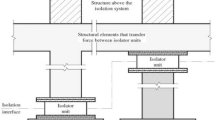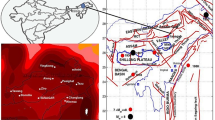Abstract
This paper addresses the analytical evaluation of soil lateral heterogeneity effects, especially the random fluctuations of the soil layer’s predominant frequency, on the spatial coherency of ground motion and the seismic response of multi-support structures. A coherency probabilistic model is proposed. In this model, the spatial variation of motion is attributed to wave passage effects, effects of loss of coherence in the bedrock motion and particularly site response effects (based on the assumption of vertically propagating shear-waves through a horizontal layer with random characteristics). The results indicate that soil lateral heterogeneity effects tend to cause diminution of the values of the total coherency function. This diminution is not limited to the vicinity of the mean resonant frequency of the layer, but reaches considerably high frequencies even for relatively low values of coefficient of variation (CV of 5 to 15%). Therefore, the trend of the total coherency function (exponential decay) can be influenced significantly by site effects. Finally, the proposed coherency model is applied for two different support seismic excitations. Study results indicate that the greater the soil heterogeneity, the larger are the dynamic displacements and shear forces in the columns of the oscillator (i.e., support structure). Furthermore, these two components of the response are influenced differently by soil heterogeneity effects.
Similar content being viewed by others
References
Abrahamson N, Schneider JF and Stepp JC (1991), “Empirical Spatial Coherency Functions for Applications to Soil-structure Interaction Analyses,” Earthquake Spectra, 7(1): 1–27.
Anastasios GS, Kyriazis DP and Andreas JK (2003), “Inelastic Dynamic Analysis of RC Bridges Accounting for Spatial Variability of Ground Motion, Site Effects and Soil–structure Interaction Phenomena, Part 1: Methodology and Analytical Tools,” Earthquake Engineering and Structural Dynamics, 32: 607–627.
Assimaki D, Pecker A, Popescu R and Prevost J (2003), “Effect of Spatial Variability of Soil Properties on Surface Ground Motion,” Journal of Earthquake Engineering, 7, Special Issue 1:1–44.
Clough R and Penzien J (1993), Dynamics of Structures, 2nd edn, McGraw-Hill, New York, USA.
Cranswick E (1988), “The Information Content of High- Frequency Seismograms and the Near Surface Geologic Structure of Hard Rock Recording Sites,” Pure and Applied Geophysics, 128: 333–363.
Der Kiureghian A (1996), “A Coherency Model for Spatially Varying Ground Motions,” Earthquake Engineering and Structural Dynamics, 25: 99–111.
Der Kiureghian A and Neuenhofer A (1992), “Response Spectrum Method for Multiple-Support Seismic Excitation,” Earthquake Engineering and Structural Dynamics, 21(8): 713–740.
Ding HP, Liu QF, Jin X and Yuan YF (2004), “A Coherency Function Model of Ground Motion at Base Rock Corresponding to Strike-Slip Fault,” Acta Seismologica Sinica, 17(1): 64–69.
Feng Q and Hu Y (1981), “Spatial Correlation Model of Ground Motion,” Earthquake Engineering and Engineering Vibration, 1(2): 1–8.
Hadid M and Afra H (2000), “Sensitivity Analysis of Site Effects on Response Spectra of Pipelines,” Soil Dynamics and Earthquake Engineering, 20: 249–260.
Hao H, Oliveira CS and Penzien J (1989), “Multiple- Station Ground Motion Processing and Simulation Based on SMART-I Array Data,” Nuclear Engineering and Design, 111: 293–310.
Harichandran RS and Vanmarcke EH (1986), “Stochastic Variation of Earthquake Ground Motion in Space and Time,” Journal of Engineering Mechanics, 112 (2):154–174.
Hindy A and Novak M (1980), “Response of Pipelines to Random Ground Motion,” Journal of the Engineering Mechanics Division, 106(2): 339–360
Kanai K (1957), “Semi Empirical Formula for The Seismic Characteristics of The Ground,” Bulletin of the Earthquake Research Institut, 35, Tokyo, University of Tokyo: 309–325.
Kanda K (2000), “Seismic Responses of Structures Subjected to Incident Incoherent Waves Considering a Layered Media with Irregular Interfaces,” Proceedings of 12th World Conference on Earthquake Engineering, Auckland, New Zealand, August, paper no. 649.
Laouami N and Labbe P (2001), “Analytical Approach for Evaluation of Seismic Ground Motion Coherency Function,” Soil Dynamics and Earthquake Engineering, 21: 727–733.
Laouami N, Labbé P and Bahar R (2005), “Stochastic Model of Seismic Torsional Ground Motion: Application to Lotung Soft Site,” Journal of Seismology, 9: 463–472.
Liao S (2006), “Physical Characterization of Seismic Ground Motion Spatial Variation and Conditional Simulation for Performance-based Design,” Ph.D Thesis, Drexel University, USA.
Liao S and Li J (2002), “A Stochastic Approach to Site-response Component in Seismic Ground Motion Coherency Model,” Soil Dynamics and Earthquake Engineering, 22: 813–820.
Loh CH (1985), “Analysis of the Spatial Variation of Seismic Waves and Ground Movements from SMART I Data,” Earthquake Engineering and Structural Dynamics, 13: 561–581.
Loh CH and Lin SG (1990), “Directionality and Simulation in Spatial Variation of Seismic Waves,” Engineering Structures, 12(4): 134–143.
Loh CH and Yeh YT (1988), “Spatial Variation and Stochastic Modelling of Seismic Differential Ground Movement,” Earthquake Engineering and Structural Dynamics, 16(4): 583–596.
Luco JE and Wong HL (1986), “Response of a Rigid Foundation to a Spatially Random Ground Motion,” Earthquake Engineering and Structural Dynamics, 14: 891–908.
Lumb P and Holt JK (1968), “The Undrained Shear Strength of a Soft Marine Clay from Hong Kong,” Géotechnique, 18: 25–36.
Menke W, Lerner-Lam AL, Dubendorff B and Pacheco J (1990), “Polarization and Coherence of 5 to 30 Hz Seismic Wave Fields at a Hard-rock Site and Their Relevance to Velocity Heterogeneities in the Crust,” Bulletin of the Seismological Society of America, 80: 430–449.
Mirzabozorg H, Akbari M and Hariri Ardebili MA (2012), “Wave Passage and Incoherency Effects on Seismic Response of High Arch Dams,” Earthquake Engineering and Engineering Vibration, 11(4): 567–578.
Nakamura H and Yamazaki F (1995), “Spatial Variation of Earthquake Ground Motion Based on Dense Array Records,” Transaction of the 13th International Conference on Structural Mechanics in Reactor Technology, 3, August, pp.19–24.
Nour A, Slimani A and Laouami N (2002), “Foundation Settlement Statistics via Finite Element Analysis,” Computers and Geotechnics, 29: 641–672.
Novak M and Hindy A (1979), “Seismic Response of Buried Pipelines,” 3rd Canadian Conference on Earthquake Engineering, Montreal, Canada.
Riepl J (1997), “Effets de Site: Evaluation Experimentale et Modelisations Multidimensionnelles. Application au Site Test EURO-SEISTEST (Grèce),” Ph.D thesis, Université Joseph-Fourier - Grenoble I, Grenoble, France.
Schneider JF, Stepp JC and Abrahamson NA (1992), “The Spatial Variation of Earthquake Ground Motion and Effects of Local Site Conditions,” Proceedings of the Tenth World Conference on Earthquake Engineering, Madrid, Spain.
Semblat JF, Kham M, Parara E, Bard PY, Pitilakis K, Makra K and Raptakis D (2005), “Seismic Wave Amplification: Basin Geometry vs Soil Layering,” Soil Dynamics and Earthquake Engineering, 25: 529–538.
Somerville PG, McLaren JP, Saikia CK and Helmberger DV (1988), “Site-specific Estimation of Spatial Incoherence of Strong Ground Motion,” Earthquake Engineering and Soil Dynamics II Conference ASCE, Geotechnical Special Publication no. 20, J. Lawrence Von Thun, Ed., 188–202.
Tamura K, Winterstein SR and Shah HC (1992), “Random Field Models of Spatially Varying Ground Motions and the Estimation of Differential Ground Motions,” Proceedings of the Tenth World Conference on Earthquake Engineering, Rotterdam, pp. 863–866.
Toksoz MN, Dainty AM and Charrette III EE (1991), “Spatial Variation of Ground Motion due to Lateral Heterogeneity,” Structural Safety, 10: 53–77.
Wang JJ and Chen H (2007), “A New Spatial Coherence Model and Analytical Coefficients for Multi-support Response Spectrum Combination,” Earthquake Engineering and Engineering Vibration, 6(3): 225–235.
Wang S and Hao H (2002), “Effects of Random Variations of Soil Properties on Site Amplification of Seismic Ground Motions,” Soil Dynamics and Earthquake Engineering, 22: 551–564.
Yang Q, Saiidi M, Wang H and Itani A (2002), “Influence of Earthquake Ground Motion Incoherency on Multi-Support Structures,” Earthquake Engineering and Engineering Vibration, 1(2): 167–180.
Ye J, Pan J and Liu X (2011), “Vertical Coherency Function Model of Spatial Ground Motion,” Earthquake Engineering and Engineering Vibration, 10(3): 403–415.
Zembaty Z and Rutenberg A (2002), “Spatial Response Spectra and Site Amplification Effects,” Engineering Structures, 24: 1485–1496.
Zerva A (1990), “Response of Multi-span Beams to Spatially Incoherent Seismic Ground Motions,” Earthquake Engineering and Structural Dynamics, 19: 819–832.
Zerva A (1992), “Spatial Incoherence Effects on Seismic Ground Strains,” Probabilistic Engineering Mechanic, 7: 217–226.
Zerva A (2009), Spatial Variation of Seismic Ground Motions: Modeling and Engineering Applications, CRC Press, Taylor and Francis Group, LLC., USA.
Zerva A and Harada T (1997), “Effect of Surface Layer Stochasticity on Seismic Ground Motion Coherence and Strain Estimates,” Soil Dynamics and Earthquake Engineering, 16: 445–457.
Zerva A and Zervas V (2002), “Spatial Variation of Seismic Ground Motions: an Overview,” Applied Mechanics Review, 55(3): 271–297.
Author information
Authors and Affiliations
Corresponding author
Rights and permissions
About this article
Cite this article
Laib, A., Laouami, N. & Slimani, A. Modeling of soil heterogeneity and its effects on seismic response of multi-support structures. Earthq. Eng. Eng. Vib. 14, 423–437 (2015). https://doi.org/10.1007/s11803-015-0034-1
Received:
Accepted:
Published:
Issue Date:
DOI: https://doi.org/10.1007/s11803-015-0034-1




